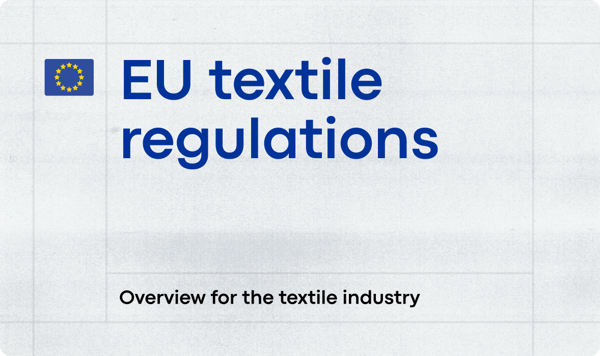The Corporate Sustainability Reporting Directive (CSRD) will soon become a key regulatory reporting requirement, impacting fashion and textile brands of nearly all sizes. The CSRD mandates that textile companies disclose non-financial information in compliance with the European Sustainability Reporting Standards (ESRS). While there are numerous standards, we’re going to take a closer look at E1, which focuses on climate change.
In this deep dive, we’ll not only demystify the “climate change standard,” but also demonstrate how your company can proactively track, measure, and report your environmental impact in compliance with the ESRS E1.
.png?width=1644&height=940&name=Energy%20consumption%204%20(1).png)
But first, what is the CSRD?
The CSRD is a regulatory framework developed as part of the European Green Deal, aimed at standardizing ESG reporting across the EU. While the CSRD touches all industries, it will have a significant impact on fashion and textile brands. It mandates yearly disclosures on environmental and social matters, the establishment and reporting of climate targets, and the creation of concrete transition plans with progress updates. These sustainability reports must also be audited.
These are the timelines for the reporting deadlines per company size:
- Phase 1, 2025: Companies currently subject to the NFRD report on 2024
- Phase 2, 2026: Large companies (both EU and non-EU) report on 2025
- Phase 3, 2027: Listed SMEs report on 2026
- Phase 4, 2028: Non-EU companies with branches in the EU report on 2027
As you can see, the CSRD applies to all listed companies operating in the EU, except micro-enterprises.
Learn more about the CSRD reporting requirements for fashion and footwear brands in our deep dive here.
.png?width=1644&height=940&name=Energy%20consumption%205%20(2).png)
The European Sustainability Reporting Standards (ESRS)
In 2023, the European Commission introduced the ESRS to standardize sustainability reporting across the EU in line with the CSRD. Previously, the collection and measurement of sustainability information varied significantly, leading to reports that often lacked crucial information for investors and stakeholders and making data comparison difficult. The ESRS aim to ensure that companies provide comparable and reliable sustainability information.
The ESRS outline how and what information and ESG metrics fashion brands need to report to European regulators to comply with the CSRD. Overall there are 12 European Sustainability Reporting Standards (ESRS), which can be condensed into four groups: Cross-cutting, Environment, Social, and Governance.
Cross-cutting, ESRS 1 & ESRS 2:
These standards encompass General Requirements and General Disclosures, which “cross-cut” different sectors and industries. ESRS 1 establishes general requirements, such as important concepts and principles, that must be followed when reporting under the CSRD, while ESRS 2 outlines reporting requirements that must be followed under the three topical standards (Environment, Social, and Governance).
ESRS 1 also introduces the double materiality assessment, which emphasizes the consideration of both the external impacts of an organization’s activities on the environment and society, and the internal impacts of sustainability factors on the organization's financial performance.
A key principle of the ESRS is "double materiality," which requires companies to report on two fronts: 1) how their business activities impact people and the environment; and 2) how environmental and social issues, such as climate change, affect the company financially. This requirement extends beyond immediate operations to the entire value chain.
Environment (ESRS E1-E5):
These five standards require textile brands to disclose information on GHG emissions, air and water pollution, impacts on biodiversity, resource usage, and circularity. Remember, this is across the entire supply chain, so you’ll need to report about everything from where materials are sourced to end-of-life for each product.
Social (ESRS S1-S4):
ESRS S1 to S4 represent the social indicators, offering a structured approach for apparel and footwear companies to report on their social and human rights performance. These provide information on social matters, including employee-related aspects, human rights, and diversity policies. This includes company employees as well as workers across the supply chain.
Governance (ESRS G1):
The governance standard emphasizes corporate governance, including structures, processes, and policies that influence decision-making within an organization. It encourages transparency and accountability in disclosing information related to governance structures, the composition of boards, and measures taken to ensure ethical and responsible business practices. Companies are asked to describe their business model and how sustainability considerations are integrated into their business strategy. They are also required to report on how the company identifies and manages sustainability-related risks.
.png?width=1644&height=940&name=Energy%20consumption%206%20(4).png)
The European Commission will also develop specific standards for the most impacting industries, including apparel and footwear. However, the textile sector-specific ESRS standards will be delayed by two years. This means that they will be published in 2026 instead of 2024. This has no implications on the CSRD reporting timelines for apparel and footwear brands.
ESRS E1 Guide for Textile Brands: Climate Change
Let’s walk through the preparation of ESRS E1 reporting, beginning with a double materiality assessment. This is a written narrative that is used to evaluate and identify the material impacts, risks, and opportunities that will eventually be reported for the CSRD. For fashion and textile brands, this will absolutely include all environmental standards.
You will need to include your company’s impacts on climate change—for example, Scope 1, 2, and 3 emissions— in the materiality assessment. Additionally, you will detail to what extent climate change can affect your organization. This could include your capacity to source materials, manufacture in specific countries, or even the ability to sell certain products.
Tip: This narrative, while primarily produced in a written format, should also include detailed graphs and charts to illustrate your findings. That’s why it’s essential to have a clear understanding of your data across the entire value chain.
ESRS E1: Overview
E-1: Transition plan
From here, you will be able to develop a transition plan, in which you create a clear strategy for tackling these issues. Here are three key elements to include:
- Your baseline emission data
- Specific decarbonization initiatives that you have identified
- Concrete goals for limiting the global increase in temperature to 1.5 C, in line with the Paris Climate Agreement
The transition plan is essentially a transparency exercise. The targets you lay out in your plan won’t necessarily be judged upon their ambition or whether or not you are currently on track to achieve them, but rather the detail of the information you provide and your strategy.
This level of reporting and data insight requires both a bird and a worm’s eye view.
.png?width=1644&height=940&name=CSRD%20Reporting%20(2).png)
In Carbonfact you can simulate supply chain changes to build concrete transition plans, required for your CSRD disclosure.
Once you have a good understanding of the source of the impact, our company modeling tool can create simulations for reducing emissions. By using real data from your catalog, this process provides meaningful targets to include in your transition plan. This information can be directly plugged into your report, making the process both transparent and easy.
E-2: Climate change policies
Once you’ve identified a strategy, you will need to broadcast the policies that your business will put into place to achieve it. This involves identifying specific actions your team will take and the resources required to achieve these goals, addressing both mitigation practices and climate adaptation procedures.
To start, it’s essential to develop and clearly communicate the policies that will guide your ESRS E1 reporting efforts. These policies should cover the entire scope of your business's environmental impact, as well as that of your value chain. For example, you could identify a set of preferred materials that your designs will use in order to reduce emissions or convert a percentage of your energy sources to renewables.
E-3: Actions and Resources
Once policies are in place, you can outline the specific actions your team will take to implement them. This includes detailed steps for reducing GHG emissions, improving energy efficiency, and deploying renewable energy sources. You should also consider the necessary resources—both financial and organizational—to support these actions.
Again, you’ll need to include detailed graphs to support your written narrative.
E-4: Targets
The CSRD requires companies to set climate-related targets. In practice, this involves not only understanding and disclosing your GHG emissions across Scope 1, Scope 2, and Scope 3, but also establishing clear, actionable goals for reducing these emissions. At this stage, you’ll set targets for at least 2030, and then for every five-year period thereafter. To foster comparability, when setting new targets, the base year chosen should be less should be less than 3 years preceding the new target period. For example, when the target period is 2025-2030, the base year should be from within 2022-2025.
In order to set GHG emission targets, you will need to present either their absolute value—in tons of CO2 equivalent or as a percentage of emissions of a base year— and, potentially, their intensity value. Targets, of course, can’t be pulled out of thin air. You’ll need to state if your emission reduction goals are science-based and compatible with the 1.5°C threshold.
.png?width=1644&height=1076&name=CSRD%20Reporting%20(3).png)
In Carbonfact you can set and track reduction targets that are aligned with the CSRD requirement and easily embed them into your CSRD report.
Lastly, your report should specify the guidance or framework used in setting these targets, including the underlying climate and policy scenarios. Be sure to explain critical assumptions made, considering future developments like sales volumes, customer preferences, regulatory factors, and new technologies, and their impact on GHG emissions. From there, you’ll need to describe your intended decarbonization levers, such as improving energy and material efficiency, reducing consumption, and switching to alternative fuels, along with their quantitative contributions to achieving the targets.
E-5: Energy consumption and mix
The Disclosure Requirement also digs into both the amount and type of energy used by your business. In order to fully report on your company’s energy consumption, you’ll need to track fuel consumption from both renewable and non-renewable energy sources. Both types of energy sources will need to be broken down into the category of energy type; for example, coal, oil, natural gas, biomass, or any self-generated renewable energy. Additionally, the report should disclose your energy intensity based on net revenue, particularly activities in high climate impact sectors.
This is where Carbonfact can help make sense of and present information about energy consumption throughout your value chain. Our fashion-specific platform enables companies to track energy consumption at a granular level, defining the source type, origin, level of output, and percentage of your overall usage.
.png?width=1644&height=940&name=Energy%20consumption%201%20(1).png)
With the help of Carbonfact, you can measure and report your energy consumption for Scope 1, 2 and 3.
E-6: – Gross Scopes 1, 2, 3 and Total GHG emissions
ESRS E1-6 is essentially a GHG inventory and needs to be performed in alignment with the GHG Protocol methodology for Carbon Accounting. As we’ve mentioned, companies will be required to report on Scopes 1, 2, and 3. Here’s a quick review of what that means:
- Scope 1: Direct emissions from owned or controlled sources, such as emissions from company vehicles and on-site fuel combustion.
- Scope 2: Indirect emissions from the generation of purchased electricity, steam, heating, and cooling consumed by the reporting company.
- Scope 3: All other indirect emissions that occur in the value chain of the reporting company, including both upstream and downstream emissions such as those from purchased goods and services, business travel, waste disposal, and product use. Read more about Carbon Accounting here.
That’s a lot of data that needs to be aggregated and presented in a comprehensive manner. Because Carbonfact sources data directly from your company and value chain, we can clearly display percentages of GHG emissions for each scope. For example, if we look at Scope 3—which comprises 95% of a company’s carbon emissions—we can visualize each emission source in granular detail, such as employee commutes or waste generated.
.png?width=1644&height=940&name=Energy%20consumption%202%20(1).png)
Carbonfact performs your Carbon Accounting and aggregates your product emissions into an actionable Scope 3 GHG inventory.
E-7: GHG removals and GHG mitigation projects financed through carbon credits
If your company is directly participating in GHG removals or purchasing carbon credits to finance removals and mitigation projects, you will be able to disclose this information in your report. This can be presented as:
- GHG removals and storage from your company’s operations or your value chain, presented in metric tonnes of CO2eq. This data will need to be broken and viewed by removal activity.
- The amount of GHG emission reductions or removals from outside your value chain that have been purchased as carbon credits. This involves providing the total amount of carbon credits verified against recognized standards, the amount canceled during the reporting period, and any planned cancellations based on existing agreements.
E-8: Internal carbon pricing
If you are employing carbon pricing schemes, you will need to disclose how they influence the implementation of climate-related policies and targets at your company. This includes specifying the type of internal carbon pricing scheme used, such as shadow prices for capital expenditures or R&D investments.
You will also need to detail the scope of application, and disclose the carbon prices applied, the critical assumptions used to determine these prices, and the sources of the prices. This should also cover the calculation methodology and alignment with science-based carbon pricing trajectories. Finally, E8 will require you to report the approximate GHG emissions by Scopes 1, 2, and 3 covered by these schemes, as well as their share of the company’s overall GHG emissions.
E-9: Potential financial effects from material physical and transition risks and potential climate-related opportunities
This final disclosure looks at the financial risk—including cash flows, performance, and cost of capital—that both climate change and your stated transition plan present. In addition to identifying risks, companies must disclose potential climate-related opportunities that could have positive financial impacts. For example, cost savings through energy efficiency, revenue generation from sustainable products, and access to new markets driven by the transition to low-carbon solutions. Disclosures should provide a detailed analysis of these opportunities, including quantitative and qualitative information, scenario analysis, and management strategies to capitalize on them.
Demystifying ESRS E1: Climate Change
There’s no way around it: CSRD reporting is a substantial, detail-oriented process for any company. The scope of data required to not only provide meaningful metrics, but also analyze and produce comprehensive reports is huge.
The structure of the ESRS E1 might seem complex at first. However, the illustration below clarifies how the ESRS E1 addresses climate change and how you can interpret it. The 116 data points required can be consolidated into three concrete projects. First, understand your company's impact on climate change by calculating and reporting your greenhouse gas emissions. The second step is to figure out how to reduce these emissions by setting climate targets and creating a roadmap for decarbonization to limit global warming to 1.5°C. The third step is to manage the opportunities and risks that arise with climate change, implementing policies to help achieve your targets, including managing financial risks and opportunities.

How Carbonfact supports CSRD reporting
Carbonfact was designed to tackle sustainability reporting, specifically for fashion and textile brands. Our customized CSRD tools are built to track, measure and report in accordance with ESRS. In fact, you can export your CSRD report directly from the Carbonfact platform.
Watch the demo of our CSRD and read more about our CSRD reporting solution for fashion and footwear here.
Textile Regulations Definite Guide



-1.png?width=1644&height=940&name=Energy%20consumption%207%20(1)-1.png)




![[Guide] Carbon accounting for fashion, textile, apparel, and footwear companies](https://www.carbonfact.com/hs-fs/hubfs/CA%20-%20Opt1.png?width=600&name=CA%20-%20Opt1.png)
 Angie Wu
Angie Wu

 Lidia Lüttin
Lidia Lüttin
